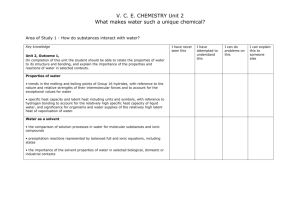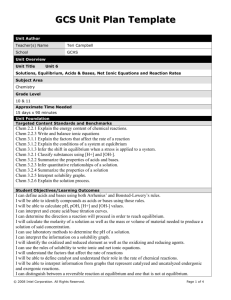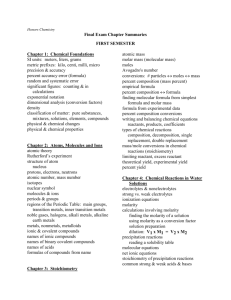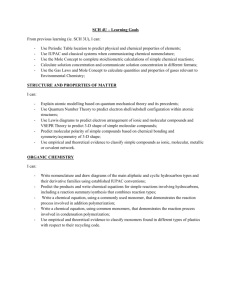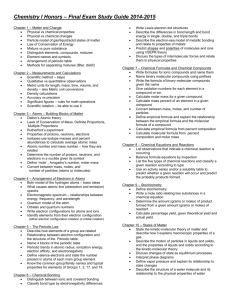AP Chemistry-chapter 3 reading guide-Kotz
advertisement
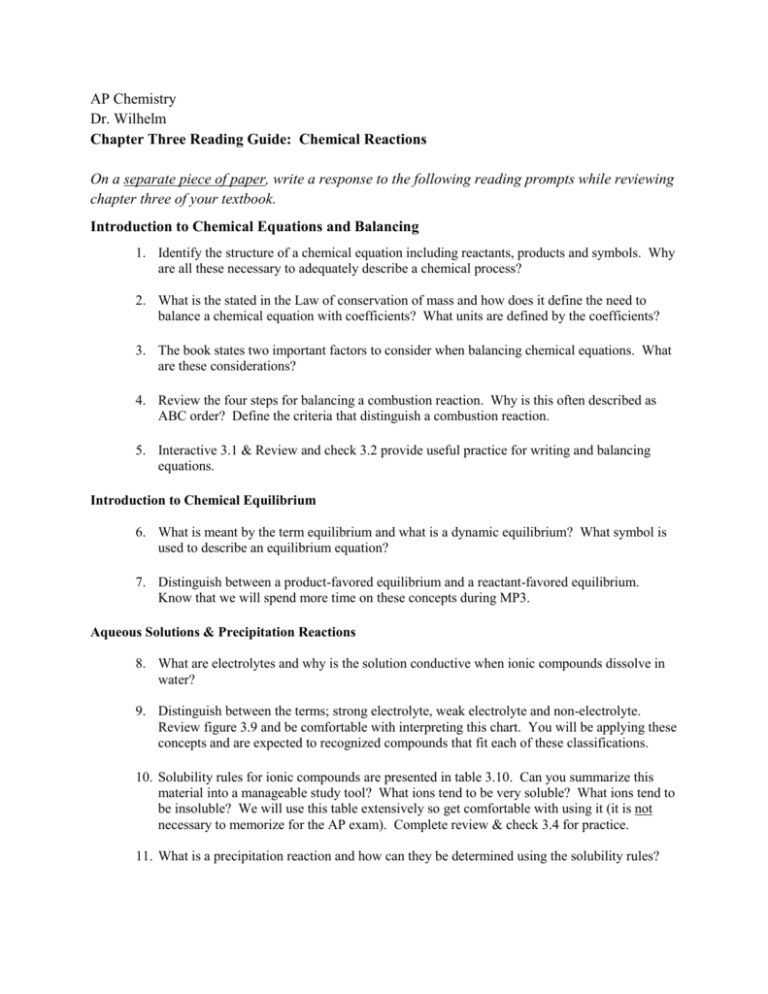
AP Chemistry Dr. Wilhelm Chapter Three Reading Guide: Chemical Reactions On a separate piece of paper, write a response to the following reading prompts while reviewing chapter three of your textbook. Introduction to Chemical Equations and Balancing 1. Identify the structure of a chemical equation including reactants, products and symbols. Why are all these necessary to adequately describe a chemical process? 2. What is the stated in the Law of conservation of mass and how does it define the need to balance a chemical equation with coefficients? What units are defined by the coefficients? 3. The book states two important factors to consider when balancing chemical equations. What are these considerations? 4. Review the four steps for balancing a combustion reaction. Why is this often described as ABC order? Define the criteria that distinguish a combustion reaction. 5. Interactive 3.1 & Review and check 3.2 provide useful practice for writing and balancing equations. Introduction to Chemical Equilibrium 6. What is meant by the term equilibrium and what is a dynamic equilibrium? What symbol is used to describe an equilibrium equation? 7. Distinguish between a product-favored equilibrium and a reactant-favored equilibrium. Know that we will spend more time on these concepts during MP3. Aqueous Solutions & Precipitation Reactions 8. What are electrolytes and why is the solution conductive when ionic compounds dissolve in water? 9. Distinguish between the terms; strong electrolyte, weak electrolyte and non-electrolyte. Review figure 3.9 and be comfortable with interpreting this chart. You will be applying these concepts and are expected to recognized compounds that fit each of these classifications. 10. Solubility rules for ionic compounds are presented in table 3.10. Can you summarize this material into a manageable study tool? What ions tend to be very soluble? What ions tend to be insoluble? We will use this table extensively so get comfortable with using it (it is not necessary to memorize for the AP exam). Complete review & check 3.4 for practice. 11. What is a precipitation reaction and how can they be determined using the solubility rules? 12. Define spectator ions and distinguish between a complete ionic equation and a net ionic equation. Summarize the four step technique for writing net ionic equations as described in Problem solving tip 3.1 (blue-shaded box, page 126) and complete the review & check section 3.5. Acids and Bases & Gas-Forming Reactions 13. What is the Arrhenius definition of an acid and a base? What makes some acids/bases strong and why are some acid/bases considered weak? What do the terms “strong” and “weak” describe? 14. Memorize the common acids in table 3.1 and be able to identify the 6 strong acids and the strong bases. 15. What is the Bronsted-Lowry definition of an acid and a base? How does this differ from the Arrhenius definition? 16. Be comfortable with the term- hydronium ion. What does this mean? 17. Give an example of an acid-base (neutralization) reaction. Write the net ionic equation. 18. Distinguish between acidic oxides and basic oxides. 19. Why do carbonate compounds produce gas when mixed with acids? Give an example of a gas forming reaction. Oxidation- Reductions Reactions 20. Explain the concept of an oxidation-reduction (redox) reaction based on the role of the electrons. When is a substance reduced? When is it oxidized? Why is it necessary that both reactions occur? 21. What are oxidation numbers ( A closer look: Are oxidations Numbers Real is helpful)? Identify the seven guidelines that allow us to determine the oxidation number of an element in a molecule or ionic compound. 22. Table 3.4 provides a nice summary of how to recognize redox reactions. This is useful to review. Complete the Review & Check 3.8 for practice assigning oxidation numbers. 23. Chapter 20 (pgs. 895-903) also describes redox reactions and a method for balancing these equations using half reactions. Interactive 20.1 outlines the steps for this procedure. 24. Redox reactions may occur in the presence of an acid or a base. Review the procedures for balancing redox reactions in acidic and basic conditions. We will practice this together. Chapter Summary 25. Section 3.9 of the text provides a nice summary of the types of aqueous reactions described in this chapter. Review this and be comfortable with recognizing reactions and writing net ionic equations for these reactions. Interactive 3.10 is also very good for practice.




